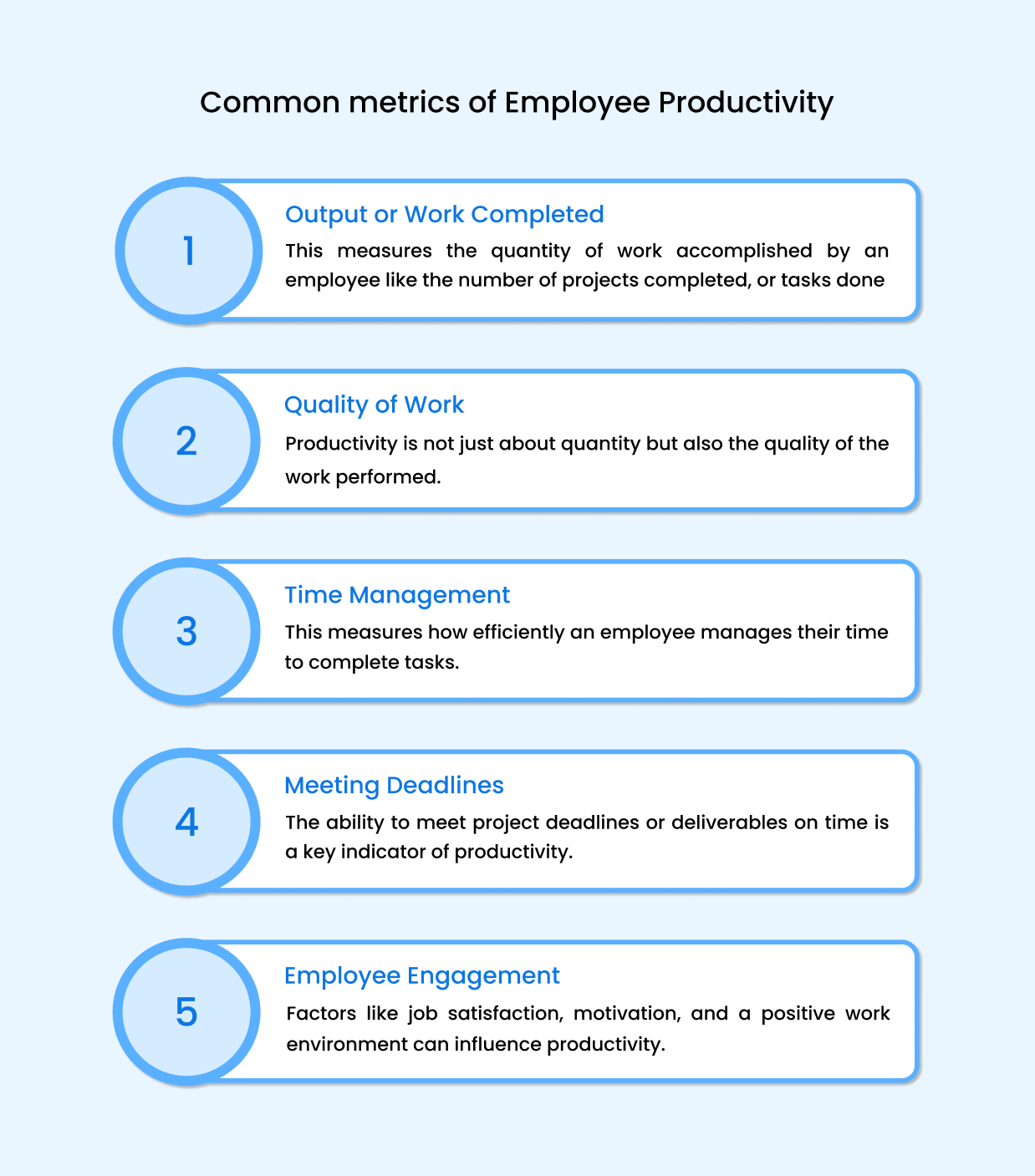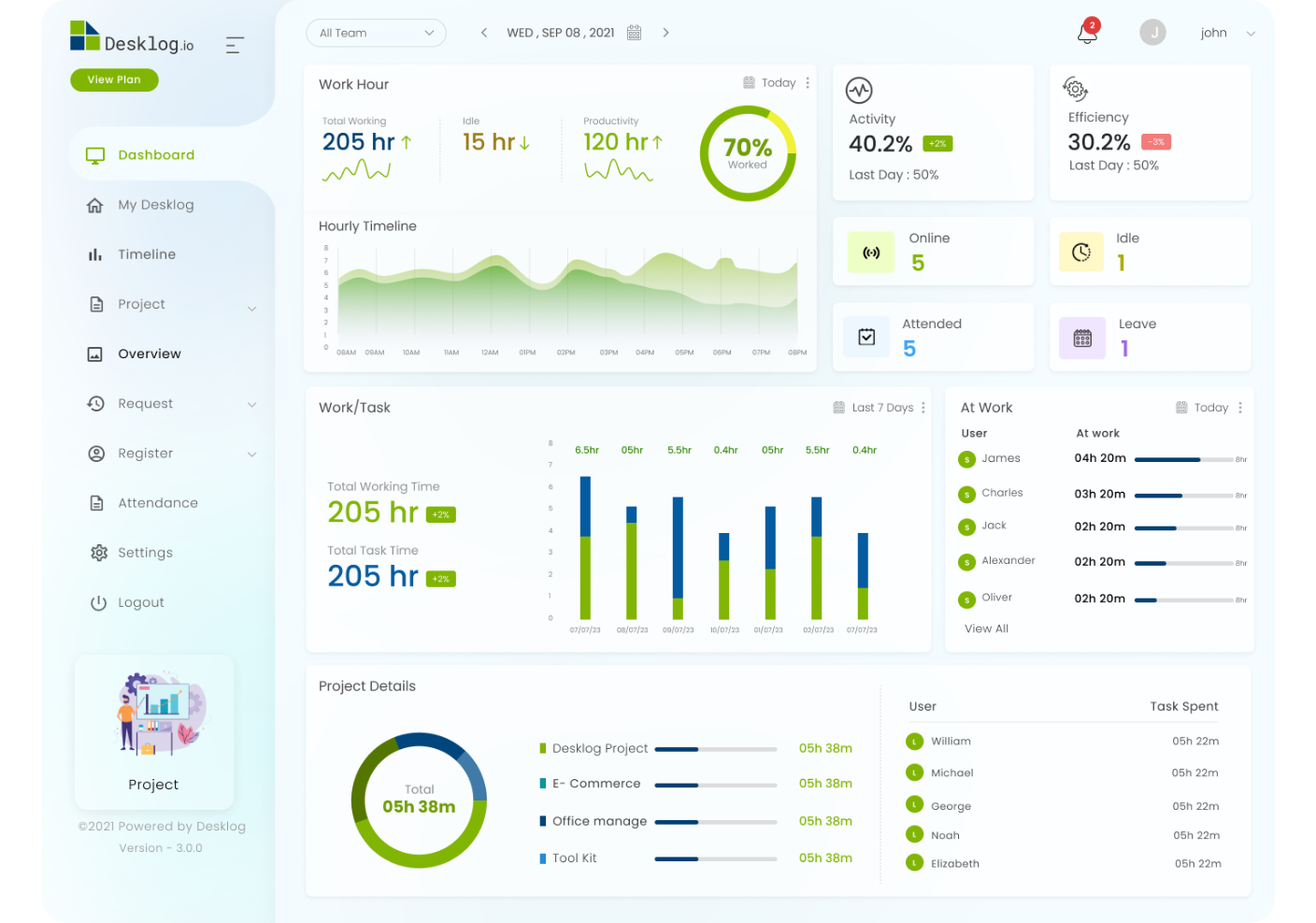10 Tips to Boost Employee Productivity In The Workplace
Productivity is the measure of how efficiently effort or resources are used in a system. It often portrays how prolific, fruitful, and constructive employees have been at their job. Lately, it seems like the whole world has been obsessed with Employee productivity. In the coming generations, employee productivity will be the defining factor for a company’s success in this competitive world.
Therefore, Entrepreneurs, employees, and managers everywhere are redefining productivity and coming up with new ways to be more and more productive. Companies are making office spaces more fun-oriented and recreational, providing more holidays, hybrid working options, and much more to boost employee productivity.
What is Employee Productivity?
Employee productivity refers to the measure of an employee’s efficiency to convert their time and effort into quality work within a given timeframe. It is a key indicator of an employee’s contribution to an organization’s goals and overall performance. Productivity can be influenced in various ways, depending on the nature of the work and the organization’s goals.

1. Track time for tasks
Tasks being completed on time are essential for the workflow of any company. It is essential to keep track of how your teams spend their work hours. Many employees often struggle to manually recollect the tasks they have done and the time taken for those. Companies can analyze things like how much time it takes to complete different tasks, how many tasks are completed in a day, the performance of different employees, and much more using this data. This will motivate employees to perform better, complete tasks on time, and boost their Employee productivity. The project tracking feature of Desklog can help track and analyze the project and tasks.
2. Take regular breaks
Taking regular breaks is proven to improve the productivity of employees. These refresh the mind and bodies of workers and help them feel fresher and more active throughout the workday. Mistakes due to inattention and or fatigue will decrease. Health and posture issues due to working long hours in a set position can be eliminated.Employees can stretch their muscles and recall the things they have done in the past hour or so. Modern-day companies have realized the importance of regular breaks, and have set up designated break rooms with ping-pong tables, mini basketball courts, or gyms.
3. Avoid unnecessary meetings
Unnecessary meetings are one of the biggest enemies of employee productivity. There are circumstances in which meetings are absolutely necessary, but many unwanted meetings plague the productive workflow of employees. Meetings are important for improving collaboration, creativity, and innovation in an organization.It fosters relationships between employees and can improve clarity in projects. But many meetings are conducted on issues that can easily be discussed over emails or phone calls. So make sure to avoid unnecessary meetings that disrupt the productivity of employees.
Tips To Enhance Employee Time Management By Using Desklog
4. Do not multitask
Doing multiple things at once does not mean that your productivity will be increased. You won’t be able to pay enough attention to all tasks, interrupts workflow, and is actually bad for your brain. Some people take pride in their ability to juggle multiple tasks at once. But this takes away the focus needed to accomplish tasks flawlessly.Multitasking increases the possibility of mistakes and the creativity of the employee will be limited. You may think that you are being more productive and efficient, but your productivity is being restricted and efficiency reduced.
5. Minimize distractions
Desklog can keep track of the website and app usage of your team. This will make them restrict the temptation to get distracted at work Distractions have an interesting dynamic with employee productivity. Employees need to be distracted from time to time or they risk being burned out. But if these distractions take up too much time, their productivity will be affected. Frequent distractions can hinder the focus of employees, prompt errors, and prevent them from getting work done on time.Checking a text or a quick look at social media could send someone down a spiral of unproductivity. Desklog can keep track of the website and app usage of your team. This will make them restrict the temptation to get distracted at work.
6. To-do lists
To-do lists are great for employee productivity. They can help you become more systematic, improve your focus, and most importantly that feeling of satisfaction when you check off completed tasks from the list.It is always better to practice 1-3-5 rule, so you don’t have to spend the start of your workday thinking about it.It is always better to prepare a to-do list the day before, so you don’t have to spend the start of your workday thinking about it. You can login and start working away at full throttle. Also, try to limit the number of items on your to-do list. Taking up too many tasks can limit your output.
Learn more about How to Track Employees Working from Home?
7. Delegate effectively
Effective delegation is a tool that can easily ramp up your productivity. But it is important to differentiate between delegation and micromanaging. You cannot delegate a task to someone, and spend the whole time looking over their shoulders. That is micromanagement and most employees do not like to be micromanaged. It is important to delegate tasks to the person most suited for the job.
Know 8 Effective Tactics for Improving Developer’s Productivity
8. Maintain your overall well-being
Productivity starts from the inside. Your physical and mental state is reflected in your productivity. It is proven that physical activity improves brain functions. Try to get some exercise every day. It is even better if you do it in between work sessions.You will get refreshed and can continue work with improved focus and vigor. It is also important to get enough sleep before you work. Lack of sleep can affect your concentration and make you unable to focus on tasks for continued durations.
9. Be proactive
Become proactive in your work hours instead of being reactive to everything that is happening around you. You can set some time aside for tasks that need you to respond to things and deal with them only then. You cannot let such tasks dictate the course of your workday. Ideally, you should have a plan for each day, and try to stick to it as much as you can.
10. Use time and productivity tracking software
One of the best ways to boost employee productivity in the workplace is to use time and productivity tracking software like Desklog. It has advanced features like automated time tracking, idle time tracking, productivity reports, offline time tracking, etc to maintain your team’s productivity.
Desklog is a solid investment for organizations of all types. It keeps your workers constantly motivated and at their productive best. You can try out the software on a 14-day free trial to see if it suits your requirements.
What Factors Affect Your Team’s Productivity?
Employee productivity is the cornerstone of any successful team, but it doesn’t exist in a vacuum. Several key factors influence how productive your team can be. Let’s dive into the critical elements that impact employee productivity and how to maximize them.
1. Work Environment
A cluttered, disorganized workspace can lead to distractions and decreased productivity. To counter this, create an organized and comfortable environment that fosters focus and creativity. In addition, remember that adequate lighting and comfortable temperatures are essential for maintaining employee focus and overall well-being.
2. Management Practices
Supportive, communicative, and inspiring leaders have the power to motivate employees to perform at their best. When these elements work in tandem, employees become more efficient and more confident in their work, leading to higher levels of productivity and job satisfaction.
3. Workload and Task Management
Overloading employees with tasks can lead to burnout, while underloading can cause boredom and underutilization of skills. To strike the right balance, it’s important to ensure each team member has an appropriate workload. Additionally, guiding your team in effective task prioritization, with a focus on high-impact activities, can enhance efficiency and overall productivity by directing energy toward tasks that matter most.
4. Communication and Collaboration
Encourage open and honest communication within your team to proactively resolve issues and prevent misunderstandings that could hinder productivity. Alongside this, ensure that your team has access to the right collaborative tools and technology, facilitating seamless communication and cooperation.
5. Well-being and Health
Support your team in maintaining a healthy work-life balance to prevent burnout and boost morale. In addition to this, promote physical and mental well-being through initiatives like wellness programs and stress management, ensuring that your team’s overall health and happiness are prioritized, leading to greater productivity and satisfaction.
6. Recognition and Motivation
Acknowledging and rewarding employees for their efforts not only boosts motivation but also enhances productivity. The combination of external recognition and internal drive can be a powerful catalyst for higher levels of productivity and engagement among your team members.
The Importance of Employee Productivity in an Organization
In the fast-paced and competitive landscape, employee productivity stands as a linchpin for success. It’s not just about how much work gets done but how efficiently and effectively it’s accomplished. Employee productivity can make or break an organization, and here’s why it holds such paramount importance.
1. Maximizing Efficiency
Employee productivity is all about doing more with less. When your team is highly productive, tasks are completed faster and with fewer resources. This efficiency directly impacts the bottom line by reducing costs and increasing profitability.
2. Competitive Advantage
In a global marketplace, staying ahead of the competition is crucial. A highly productive workforce enables you to outperform rivals, meet market demands, and respond to changes more swiftly.
3. Resource Optimization
A focus on employee productivity helps in the efficient allocation of resources. Instead of overloading some and underutilizing others, you can allocate resources based on actual needs, reducing waste and redundancy.
4. Quality Enhancement
High levels of productivity do not come at the cost of quality. In fact, employees who are efficient tend to have the time and energy to maintain and even improve the quality of their work.
5. Employee Satisfaction
When employees feel their work is contributing to the organization’s success, it boosts their job satisfaction and morale. This, in turn, has a positive impact on employee retention, reducing recruitment and training costs.
6. Innovation and Growth
Productive employees are more likely to have the bandwidth to think creatively and innovate. This innovation can lead to the development of new products, services, or processes, fostering growth and adaptability.
7. Customer Satisfaction
Productive teams can better meet customer needs and expectations, resulting in higher customer satisfaction, loyalty, and positive word-of-mouth referrals.
8. Time Management
Effective time management is a cornerstone of productivity. When employees learn to manage their time efficiently, they can complete tasks promptly, meet deadlines, and take on more responsibilities.
What Causes Low Productivity?
Productivity is the lifeblood of any successful organization, yet there are times when it seems to plummet, leaving employers and employees frustrated. Low productivity can manifest to many challenges. To address and overcome this challenge, it’s essential to understand the underlying causes. Here are the common factors that contribute to low productivity.
1. Poor Time Management
One of the primary culprits of low productivity is poor time management. Employees who struggle with managing their time often find themselves overwhelmed with tasks, leading to inefficiency and reduced output.
2. Lack of Motivation
When employees lack motivation, it’s challenging for them to stay focused and dedicated to their work. This lack of enthusiasm can significantly impact productivity.
3. Inadequate Training
Employees may not be equipped with the necessary skills and knowledge to perform their tasks efficiently. This can lead to frustration and decreased productivity as they struggle to complete their work effectively.
4. Multitasking
Contrary to popular belief, multitasking often results in reduced productivity. Switching between tasks can lead to mental fatigue, decreased concentration, and more mistakes.
5. Workspace Issues
A disorganized or uncomfortable workspace can be a major distraction and negatively impact productivity. Clutter, poor lighting, and uncomfortable seating can all contribute to low productivity.
6. Workload Imbalance
Overloading employees with excessive tasks or not giving them enough to do can both lead to low productivity. Finding the right balance is key.
7. Technology Distractions
Constant digital distractions, such as social media, email, and messaging apps, can divert employees’ attention from their work, making it difficult to focus and complete tasks efficiently.
8. Lack of Clear Goals
Employees who are unsure of their goals or tasks may feel directionless and demotivated, resulting in reduced productivity.
9. Negative Company Culture
A toxic or unsupportive company culture can also contribute to low productivity, as it affects the overall mood and motivation of the workforce.
10. Lack of Feedback and Recognition
One of the primary culprits of low productivity is poor time management. Employees who struggle with managing their time often find themselves overwhelmed with tasks, leading to inefficiency and reduced output.Employees who do not receive feedback or recognition for their efforts may feel undervalued and less motivated to excel in their roles.
Toxic Productivity
Well, higher productivity is also a risk factor leading to toxic productivity. Toxic productivity is a harmful mindset that can lead to burnout and negatively impact your well-being. To avoid falling into this trap, consider the following points:
- Set Realistic Goals
- Prioritize Self-Care
- Embrace Imperfection
- Practice Mindfulness
- Set Boundaries
- Learn to Say No
- Time Management
- Take Breaks
- Avoid Comparison
- Celebrate Achievements
Want to try our Time Tracking Software?
Try Desklog for free!

In Summary
Companies everywhere are looking for new ways to improve the productivity of employees. More productive and satisfied employees directly lead to a more profitable business. These are our tried and tested 10 tips to boost productivity in the workplace. Implement these in your workplace and let us know how it turns out.



The article is well written and worth reading. Thank you for sharing the valuable information.